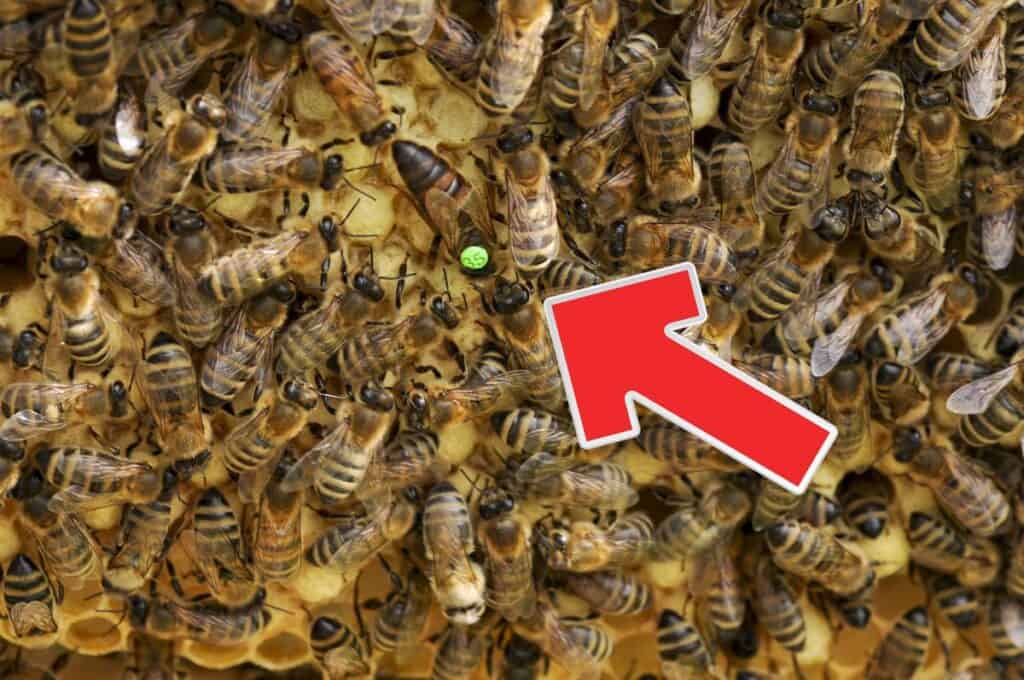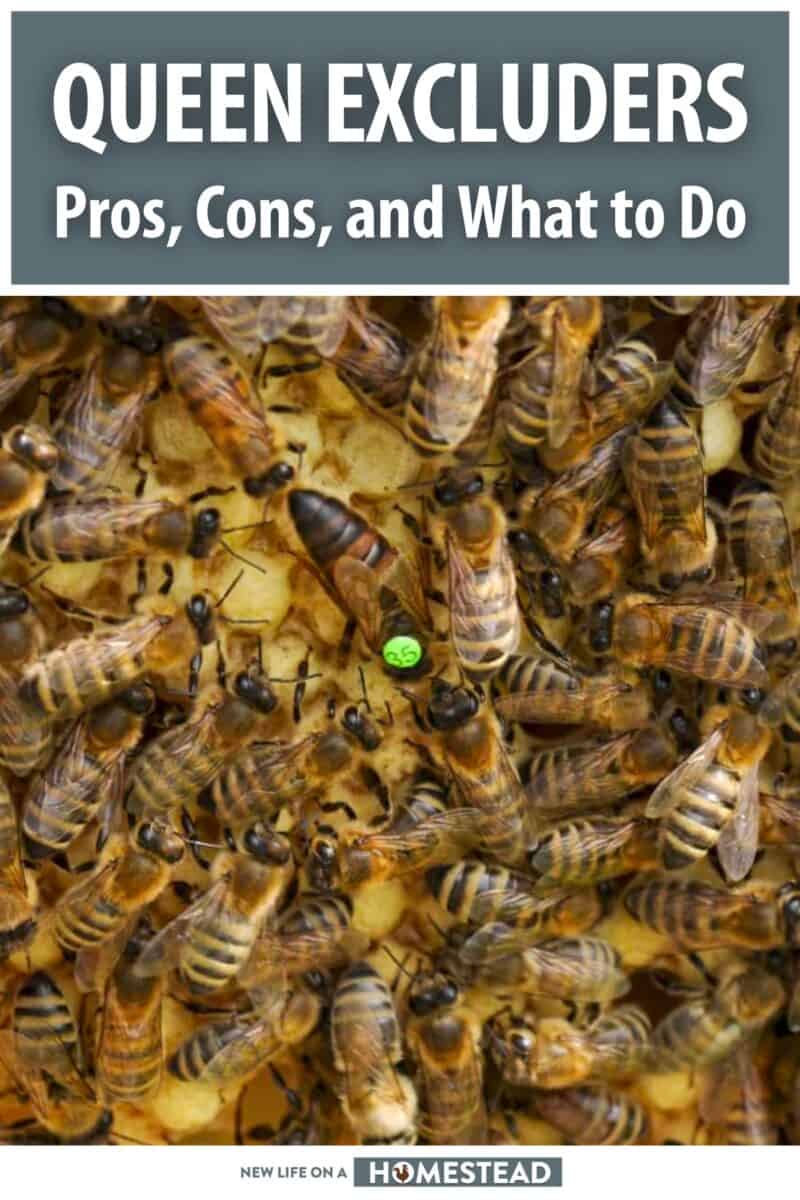The question of whether or not we should use excluders in our beehives is as old as time.

Many beekeepers say that using an excluder can cause honey production to come to a grinding halt, they are prone to calling them honey excluders because they believe the bees are not producing as much honey as they would if the excluder was not present.
Other beekeepers wax lyrical about the benefits of using an excluder as they confine the queen to the brood box and super, making it easy to find the queen and stop the queen from laying eggs in the honey supers.
It is common practice for honey farmers to use queen excluders to ensure the purity of their honey.
Making an informed decision to use or not to use is up to you. I am going to give you all the information you will need to make this decision.
What is a Queen Excluder?
A queen excluder is a mesh with big enough gaps for the workers to fit through but small enough that the queen cannot fit through. The gaps in excluders are 4.1 millimeters to 4.4 millimeters big.
A queen excluder is a barrier used inside the hive that restricts the queen’s ability to move throughout the hive.
Worker bees are smaller than the queen, making it possible for them to pass through this barrier so that they can tend to the queen, perform brood-rearing chores, and tend to the baby bees.
The queen is confined in one or two brood chambers below the excluder.
The use of an excluder makes harvesting your honey easier as the queen cannot lay eggs in the available honey cells.
Today, excluders are made of plastic, welded galvanized metal, or welded stainless wire so that they last longer.
How Does a Queen Excluder Work?
The queen bee has a larger thorax than workers. This is what makes it so easy to identify her in the hive.
An excluder essentially uses the size of the queen against herself by blocking her into one section of the hive.
She is trapped in the part of the hive where the brood cells are. The excluder does not allow her to travel into the part of the hive where the honey frames are.
This makes it easier to harvest honey as you do not need to seek out brood cells from honey cells.
If there is no queen excluder, the queen will move up into the top of the beehive where the beekeeper normally would collect honey from, and she will lay eggs in those honey cells.
This will mean that the beekeeper will not have as much honey to harvest as they would have if they had an excluder in the hive.
If allowed to lay eggs in the honey cells, the workers will be more hesitant to leave the brood cells that are in amongst the honey cells making it harder to harvest the honey.
Pros and Cons of Using an Excluder
You are reading this article because you are undecided as to whether or not it is worth using an excluder.
To make this decision, you need to understand the pros and cons of using an excluder.
| Pros | Cons |
|---|---|
| Harvesting honey does not disturb the queen | Excluders can harm the wings of worker bees reducing their lifespan |
| You will not need to identify the queen or check for brood when removing honey above the supers | Worker bees may struggle to pass through the excluders reducing the production of honey |
| Easy to find the queen | One more item to buy and maintain |
| Because she is confined to one area of the hive, health checks are quick and easy | Excluders are expensive |
| Because she is confined, it is easy to re-queen the hive as soon as the queen dies | Excluders are easily damaged |
| Most of the bees live and work in the brood cells, it is easy to remove the honey supers | Because drones are larger than workers, they may become trapped in the excluder blocking the barrier to the extent that workers cannot breach the barrier |
| Collecting wax from non-brood cells is easy | Burr comb can build up on excluders reducing airflow and causing the temperature inside the hive to rise and thus overheating the hive |
| Prevents brood cells in honey frames | Excluders can restrict the availability of space for queens to lay eggs |
| The absence of brood cells in honey frames means there will be more honey to harvest | Small, virgin, or newly mated queens can pass through the barrier making her harder to find |
| Honey in non-brood cells contain fewer impurities | Excluders don’t always work as some queens are small enough to fit through |
| Fewer brood cells mean fewer mites, which reduces diseases carried by mites | Poorly managed brood cells can lead to congestion and encourage swarming |
| Fewer wax moths | Some beekeepers have noted that the workers are reluctant to go where the queen cannot go |
| Helps to control the population of the hive | |
| Shorter harvest time |
Which is Better, Plastic or Metal?
Metal Excluder
| Pros | Cons |
|---|---|
| The smooth edges are less likely to harm worker bees as they pass through the barrier | They are very heavy |
| They can last years | They are expensive |
| They do not sag on top of the frames | Small hive beetles can move into the folded metal edges |
| They sit snuggly on top of the brood box | They can rust over time |
| They are not damaged by gamma radiation | The heat generated by the sun and by the activity inn the hive can cause the excluders to overheat |
| They are easy to clean |
Plastic Excluder
| Pros | Cons |
|---|---|
| Cheap | Easily damaged when cleaning and working in the hive |
| Does not harbor hive beetles | Gamma radiation makes the plastic brittle |
| Lightweight | Ages faster than metal excluders |
| Does not rust | May have sharp edges that could harm worker bees as they pass through the excluder |
| Does not conduct heat or cold | May warp |
| May sag | |
| Cleaning is harder as you cannot use heat when cleaning as the plastic may deform when exposed to heat | |
| Short lifespan |
Stainless steel excluders are considered to be the best excluders because of their durability and their reliable success.
Where to Put the Excluder
The queen excluder needs to be placed directly under the top honey supers that you intend to harvest.
Remember that your bees will need some honey as well during the winter months when it is too cold for them to go find pollen and nectar to produce more honey for the hive.
The excluder needs to be under the first honey collection box in the hive.
If you are using a standard hive configuration with both deep and shallow boxes, your excluder must go on top of the shallow box.
Queen Excluders in Flow Hives
Frames in flow hives contain partially formed, plastic cells with vertical gaps. Flow hives are designed to extract honey by opening a tap and allowing gravity to do the rest.
A flow hive has a clear side that allows you to see how your honey cells are progressing without opening the hive and disturbing the bees.
The hive needs inspections to ensure the health of the colony but opening up the hive and lifting the frames out of the hive to inspect the frames can cause some injuries if you are careless. An excluder will help make these checkups easier.
Excluders are highly recommended in flow hives. Not using an excluder can lead to the queen laying drone brood in the flow frame cells.
Excluders should be placed between the brood box and the flow super in a flow hive. The queen should be below the excluder.
A clear upper entrance must be available for drones to exit, or they will block the excluder when they try to leave the hive.
When is the Best Time to Add a Queen Excluder?
If you want to add a queen excluder, it is best to do this in mid spring when the temperature is starting to get warmer as the queen will move down in the hive to begin laying eggs in the brood cells.
If you are starting a new hive, you can add the excluder before you introduce your bees to their new hive; make sure the queen is below the excluder.
If the queen is still small, keep an eye on her and move her to the brood cells as soon as possible.
If you have an established hive, simply remove some of the honey, pollen, and sealed brood from the hive and place the excluder in the box.
Make sure the queen is below the excluder in the brood box when you place the excluder in the hive. Once the excluder is in place, place the honey frames above the excluder.
Make sure that you know where the queen is before putting the excluder in place.
What to do in Winter
Hot air rises. In the cold winter months, the worker bees and queen bee cluster together in the uppermost part of the hive.
Here, the bees have easy access to their honey stores, and can raise the temperature in the hive through clustering and moving around thus collecting heat in the close quarters around all the workers and around the queen.
In many parts of the southern hemisphere, where the temperature is warmer, it is not necessary to remove the excluder.
In the colder northern hemisphere, beekeepers remove the excluder for the winter months to ensure the queen survives the cold winter months.
Is the Excluder Responsible for Reduced Honey Production?
If bees are healthy, the colony is strong, the queen is alive and well, and they have a fresh, clean honey super, they will produce honey.
If you do experience a reduction in honey production, you may also notice a lot of dead worker bees to go with it.
This can be because the excluder is blocked, has sharp edges, or the holes in the excluder are too narrow.
All of these can result in the wings of the workers being harmed. If the wings are hurt, the workers cannot fly to fetch nectar and pollen and reduces the lifespan of the worker.
Try to give the excluder a good cleaning, make sure there is good airflow, ensure that there is good nectar flow, and try removing some of the honey and brood frames from the brood box and replacing them with new frames.
Tips for Successful Queen Excluder Use
Installing an upper hive entrance can encourage the workers to enter the hive from above and therefore the first cells they find are the cells that will contain the honey you harvest.
Make sure that it is warm enough for the queen and worker bees to move throughout the hive before you add the excluder.
The bees need to stay warm, and they do this in the top section of the hive during cold weather.
Remove the excluder in mid to late autumn when the weather starts to get cold. This allows the bees to migrate to the top of the hive to stay warm. This can be done as soon as you harvest your honey.
Before you place your queen excluder, make sure that there are no growing cells or brood above the queen excluder.
Unless you have a top entrance to the hive male bees (drones) will attempt to move through the excluder to get to the queen and they will become trapped and block up the excluder.
Alternatives to Using a Queen Excluder
If you don’t want to use an excluder, there are a few things you can try; however, just like using an excluder these possible avenues are not fool proof.
Try these ideas and see what works for you:
- Rotate your brood boxes; the queen migrates upwards once she has filled the brood boxes on the bottom
- Your bees will need honey cells in the brood box, this is so that they can feed the larvae and the queen; however, if there is too much honey in the brood box the queen will move up to lay eggs in the honey frames, it is therefore important that you make sure your brood box does not become honey bound
- By placing new super’s that are already filled with honey directly above the brood box you can form a honey barrier to keep the queen in the bottom of the hive
- Because queens do not like light, you can try placing an upper entrance just below your honey supers
- Make sure that every frame in your top box has either a honey crown or honey barrier before you add a honey super collection box on top.
Conclusion
Just like each class in school is completely different from other classes because of the different personalities interacting in a class, honeybee colonies can also differ from one another and can react to a queen extractor differently from how other colonies react.
Using an excluder can drastically reduce the risk of mites and wax moths collecting in the hive. This means that your risk of disease in the hive will be greatly reduced.
The benefits of using an excluder outweigh the benefits of not using an excluder.
But getting the maximum benefit from your excluder depends entirely on how you fit and maintain the excluder, and the quality of the materials used to make the excluder.
I hope you have found this article informative. What is your opinion on queen excluders? Send your opinions in the comments below.
FAQs
If honey is your priority, and you don’t want to spend a lot of time finding the queen and separating honey from brood, then you should consider using a queen excluder.
If you are keeping bees for the purpose of pollinating crops and honey is just a nice to have by-product, then a queen excluder is not an absolute necessity.
Queen excluders can harm bees if they become blocked or have sharp edges or the gap for the bees is too small to pass through without damaging their wings.
However, using a queen excluder has many health benefits that affect all the bees in the hive.
If you do not use a queen excluder, you run the risk of the queen laying eggs in the honey cells.
Plastic excluders are hard to clean as you will not be able to apply as much heat as is necessary to properly clean them without having the plastic warp, they also have a shorter life span than a metal excluder. Therefore, most beekeepers opt for metal queen excluders.
If you are going to use a queen excluder make sure that you have drawn comb above the queen excluder and have foundation above that, worker bees won’t pass through the excluder if there is only ungrown foundation above the excluder.


Di-Anne has been living on a farm her entire life. She has a gorgeous garden, and also tends to livestock big and small. She’s not raising her three children with the self-sufficient mindset.
